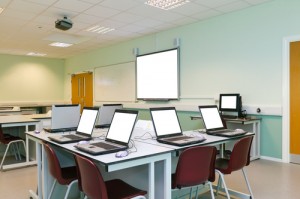Advice for Employers and Recruiters
Ten Ways to Improve Education through Technology

An IT classroom with laptops on the desks and an interactive white board with blank screens to add your own image or text. Photo courtesy of Shutterstock.
The past twenty five years have seen huge advances in technology. You only need to look at your current mobile phone with all its apps and features, and then compare it to the brick you were carrying around way back then to see the proof.
Disappointingly however, these advances in technology also have a downside. Children of today are now transfixed with all the computer games, the Internet, social media, iPods, and of course their mobile phones. No longer are children inclined to read a book, play outside with their friends or do the kind of activities that children use to do in previous generations. Furthermore the use of calculators and the spell checker on computers has taken away the very basics that are needed to lay the foundations of a good education, namely basic arithmetic and spelling.
Yet in spite of this, there are benefits to be gained through the use of technology in the educational environment. Most households in non third world countries now have access to a computer. This has been the main contributor to improvements in education, and through its use there are many ways to improve education through technology.
- The Internet
While the Internet can be blamed for having an adverse affect on the way our children now grow up, on the positive side it does give them access to a wealth of information. Research is now far easier thanks to the abundance of educational information and news that is freely available. Children should be encouraged to use the Internet to carry out research on projects that they are working on.
- E-Books
E-books are cheaper to buy than the old fashioned paperback style of text book. This means that schools and colleges have more funds available through these savings to spend on other resources. These text books now often contain assessments, videos and animation which make learning more fun and interesting. If you also take the time to look, there are many free educational books available on Amazon.
- Educational Videos
Educational videos have become an extremely popular way to self-educate. Sites such as Udemy, the Khan Academy and YouTube offer thousands of educational videos. These videos cover a wide range of subjects such as Mathematics, Science, Basics of International Finance, Business Risk Management and thousands more.
Distance learning has been made a much easier and quicker process thanks to advances in technology. Work can be submitted online rather than being sent in the mail and programs such as Skype have made it possible for students to have face to face contact and reviews with their lecturers. This can be particularly beneficial to children whose parents move from country to country for work purposes. Instead of being sent away to school, or changing schools and often curriculums, they are now able to study online for qualifications of their native country.
- Flashcards
There are now many Internet sites which provide flashcards for revision and learning. These online flashcards are far more effective and cheaper than physical flashcards, and includes pronunciation help in many languages.
- Interactive boards
Interactive whiteboards have replaced the standard whiteboard and blackboards making life for the teacher far easier. The use of interactive whiteboards enables more visual learning, and studies have shown that their use increases the interest and attention levels of students.
This is a process whereby students are given video lectures to watch as part of their homework. This enables the student to learn at their own pace and leaves more time for in class discussion and questions.
- Free study apps
There is a wide range of helpful and often free apps which can be downloaded onto a computer, iPad and even a mobile phone. Students should be made aware of such apps which can further enhance their learning. Examples of some of the top free apps are iTunes University, Exam Vocabulary Builder, Dragon Dictation, and iStudiez Lite.
- Online Conferences
Online conferences for teachers are a useful way for teachers to share ideas. Education on Air is a free online conference for educators.
- Social Media
Social media such as Facebook can be very useful in education. You can create a group for a class and encourage students to use it to discuss ideas on homework assignments. Teachers can also post homework assignments rather than having pupils wasting valuable teaching time copying down assignments from the board.
- Share your board
This app enables you to take a picture of the whiteboard used in a lecture. This will save you from the need to write down all the information in note form there and then rather than concentrating on the lecture.
iStudiez Lite
This app enables you to plan out your course, assignments, and exams for the term.
Dragon Dictation
Ideal to quickly have your notes typed up, this app digitally converts speech into text which can then be pasted into other apps.
Flashcards+
With over a million downloads, this is another extremely popular flashcard app and includes pronunciation help in twenty-two languages.
XMind
One of the best free mind mapping apps available.
Bio: Amber Woods is a newbie blogger from Chicago. She enjoys creating infographics – check them out at Mymathdone -, passionate about learning new things and writing about education in an easy-to-understand manner.